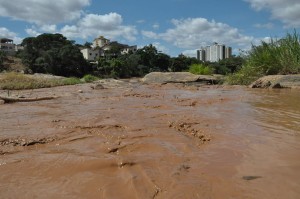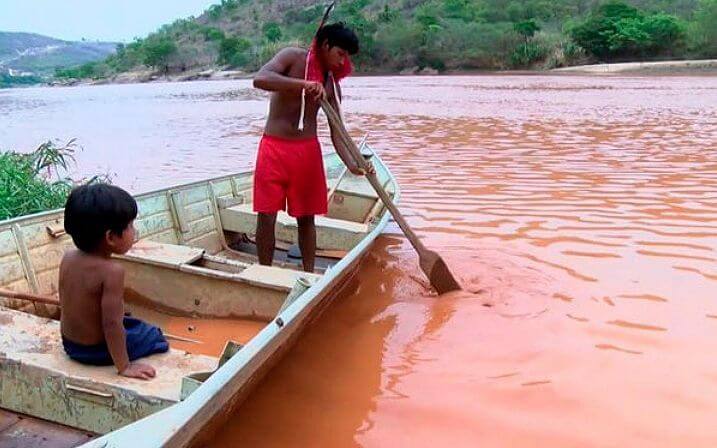
by DGR Colorado Plateau | Dec 3, 2015 | Biodiversity & Habitat Destruction, Indigenous Autonomy
by Marcela Belchior / Adital via Intercontinental Cry
What would initially appear to be the end of the line for the culture and survival of the Krenak indigenous people, impacted by the pollution of the Rio Doce, from the Mariana tragedy, in southeastern Brazil [state of Minas Gerais], could rekindle a 25 year struggle. After being left unable to live without the water of the river, the Krenak population is mobilized around a possible solution for the continuity of the community: to expand the demarcated area of the indigenous territory in the region and to migrate to a new location.
In an interview with Adital, Eduardo Cerqueira, member of the Indigenist Missionary Council (CIMI), Eastern Regional office, which comprises the states of Minas Gerais, Espírito Santo and the extreme south of Bahia, affirms that, as a way to resist the tragedy, the Krenak community [is calling] on the federal government to expand the demarcated area into 12,000 adjacent hectares, embracing the region where the State Park of Sete Salões, one of the Units of Conservation of nature belonging to the Government of Minas Gerais, is currently located.
“We find the strategy interesting, given that the existing area no longer provides conditions for survival. Something must be done”, attests Cerqueira. At present, the demarcated area of Krenak territory covers 4700 hectares. In this zone, extending more than three kilometers along the Doce River have been impacted and rendered unfit for drinking, fishing, bathing and irrigating vegetation in the vicinity, in the municipality of Resplendor, where 126 Krenak families live.
The State Park Parque de Sete Salões was created in 1998, and includes the municipalities of Conselheiro Pena, Itueta and Santa Rita do Itueto, corresponding to one of the largest remnants of Atlantic Forest in eastern Minas Gerais, with mountains, forests and waterfalls. Besides this, the area demanded has potential for indigenous community tourism, receiving visitors and marketing crafts, without damage to the environment.
The territory of the Krenak population, in Minas Gerais, was demarcated in the 1990s, but the entire length of the park was excluded, which today could once again be placed on the agenda. In the early 2000s, the Indigenous people filed a claim with the National Indian Foundation (Funai) and the federal government conducted a technical study on the matter, which to date has not been published. In the opinion of the Krenak, now, the situation is more than appropriate to fulfill the historical demand of the population.
“Various indigenous leaders are concerned about the territorial question. Now, it is a matter of necessity for this concern to be the focus of discussion. (…) This part of the region was not affected by the tailings [pollution],” defends the indigenous advocate. According to the CIMI counselor, since the socioenvironmental tragedy, the indigenous peoples affected have been assisted with emergency support, by means of tank trucks supplying water, transfer of basic food baskets and financial support for the families, which would ensure the community’s survival only in the short term.
“This tragedy was intensified by a period of severe drought. For over a year there has been no rain in the region. Because of this, the tributaries of the Rio Doce are dry. (…) The terrain is not favorable to agriculture. Livestock would be the most common form of indigenous survival, but it is not possible, without water,” explains Cerqueira.
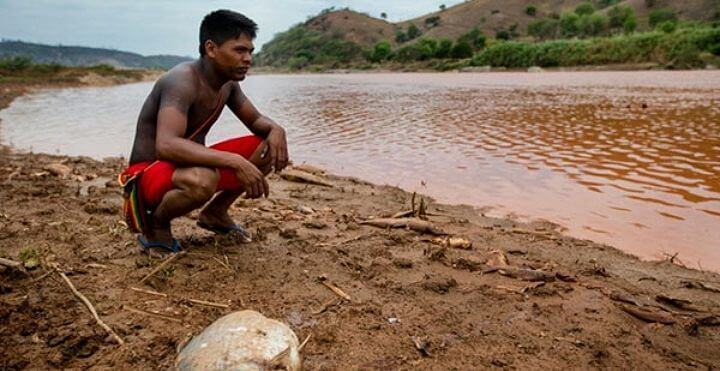
Geovani Krenak laments the death of the Rio Doce: “we are one, people and nature, only one,” he says. Photo: Reproduction.
UNDERSTANDING THE CASE
A torrent of mud composed of mining tailings (residual waste, impurities and [chemical] material used for flushing out minerals) has been flooding the 800 kilometer length of the Rio Doce since November 5, after the rupture of the Fundão dam, of the Samarco mining company. This is controlled by Vale, responsible for innumerable and grave socioenvironmental damages in Brazil, and the multinational Anglo-Australian BHP Billiton, two of the largest mining companies in the world.
In addition to burying an entire district, impacting several others and polluting the Rio Doce, extending through the states of Minas Gerais, Espírito Santo and Bahia, the mud reached the sea over the weekend, even further amplifying the environmental damage, which could take more than two decades before signs of recovery even begin to present. In addition to the destruction of fauna and flora, seven deaths and 17 disappearances have so far been recorded.
KRENAK PEOPLE CLOSE ROAD IN PROTEST
Early last week, representatives of the Krenak indigenous people, whose tribe is situated on the banks of the Rio Doce, interrupted, in protest, the Vitória-Minas Railroad. Without water for more than a week, they said they would leave only when those responsible for the tragedy talk with them. “They destroyed our lives, they razed our culture and ignore us. This we do not accept,” asserted Aiah Krenak to the press.
Considered sacred, in a culture whose cosmological worldview is based on the interconnection between all beings – humans, plants, animals, etc., the river that flows through the tribe was utilized by 350 Indians, for consumption, bathing and cleansing. “With the people, this is not separate from us, the river, trees, the creatures. We are one, people and nature, only one”, says Geovani Krenak.
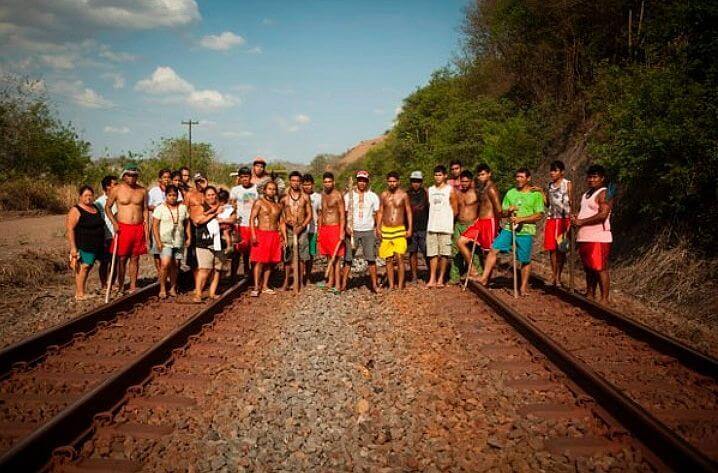
Krenak people protest on the Vitória-Minas Railroad. Photo: Reproduction.
Seated along the tracks, under a 41C. degree sun, Indians chanted music in gratitude to the river, in the Krenak language. “The river is beautiful. Thank you, God, for the river that feeds and bathes us. “The river is beautiful. Thank you, God, for our river, the river of all of us,” the words of shaman Ernani Krenak, 105 years of age, translated for the press.
His sister, Dekanira Krenak, 65 years old, is attentive to the impact of the death of the river affecting not only the indigenous peoples, being a source of resources for many communities. “It is not ‘us alone’, the whites who live on the riverbank are also in great need of this water, they coexist with this water, many fishermen [feed their] family with the fishes,” she points out.
Camped on site in tarpaulin shacks and sleeping mats in the open air, the Indians, now, must also face an unbearable swarm of insects. “It was never like this,” says Geovani Krenak. “These mosquitoes came with the polluted water, with fish that once fed us and that are now descending the river, dead, he reports.
Article originally published in Portuguese at
Adital. Translated to English for Intercontinental Cry by M.A. Kidd. Republished with permission of Intercontinental Cry.
by DGR Colorado Plateau | Nov 27, 2015 | Biodiversity & Habitat Destruction, Colonialism & Conquest
By Interamerican Association for Environmental Defense via Intercontinental Cry
Image: Mural in São Paulo, Brazil (Photo: Monica Kaneko/flickr). Some Rights Reserved
Altamira, Brazil. The Brazilian Institute of Environment and Renewable Natural Resources (IBAMA) on Tuesday authorized the Belo Monte Dam’s operating license, which allows the dam’s reservoirs to be filled. The authorization was granted despite clear noncompliance with conditions necessary to guarantee the life, health and integrity of affected communities; the same conditions that IBAMA called essential in its technical report of September 22. IBAMA’s decision makes no reference to conditions needed to protect affected indigenous peoples.
“We can’t believe it,” said Antonia Melo, leader of Movimiento Xingú Vivo para Siempre, who was displaced by the dam’s construction. “This is a crime. Granting the license for this monster was an irresponsible decision on the part of the government and IBAMA. The president of IBAMA was in Altamira on November 5 and received a large variety of complaints. Everyone – riverside residents, indigenous representatives, fishermen, and members of the movement – talked about the negative impacts we’re living with. And now they grant the license with more conditions, which will only continue to be violated.”
In an official letter to IBAMA on November 12, the president of the National Indian Foundation (FUNAI) concluded that conditions necessary for the protection of affected indigenous communities had clearly not been met. However, he gave free reign for the environmental authority to grant the operating license “if deemed appropriate.”
“The authorization clearly violates Brazil’s international human rights commitments, especially with respect to the indigenous communities of the Xingú River basin. Those affected populations are protected by precautionary measures granted in 2011 by the Inter-American Commission on Human Rights, which the Brazilian government continues to ignore,” said María José Veramendi, attorney with the Interamerican Association for Environmental Defense (AIDA).
The license allows for the filling of two of the dam’s reservoirs on the Xingú River, an Amazon tributary. It is valid for six years and is subject to compliance with certain conditions; progress will be monitored through semiannual reports. Such conditions should have been met before the dam’s license was even considered, let alone granted.
“Environmental licensing is a way to mitigate the effects, control damage and minimize the risks that the dam’s operation entails for the community and the environment. By disrespecting and making flexible the licensing procedures, the government is allowing economic interests to prevail and ignoring its duty to protect the public interest,” said Raphaela Lopes, attorney with Justiça Global.
AIDA, Justiça Global, and the Para Society of Defense of Human Rights have argued on both national and international levels that the conditions needed for Belo Monte to obtain permission to operate have not been met. The project must still guarantee affected and displaced populations access to essential services such as clean water, sanitation, health services and other basic human rights.
“The authorization of Belo Monte, a project involved in widespread corruption scandals, contradicts President Rousseff’s recent statement before the United Nations, in which she declared that Brazil would not tolerate corruption, and would instead aspire to be a country where leaders behave in strict accordance with their duties. We hope that the Brazilian government comes to its senses, and begins to align its actions with its words,” said Astrid Puentes Riaño, co-director of AIDA.
The green light for Belo Monte couldn’t have come at a worse moment. On November 5th, two dams impounding mine waste—owned by Samarco, a company jointly overseen by Vale and BHP Billiton—broke in the city of Mariana, Minas Gerais, causing one of the greatest environmental disasters in the country’s history. A slow-moving flood of mud and toxic chemicals wiped out a village, left 11 dead and 12 missing, and affected the water supply of the entire region, destroying flora and fauna for hundreds of miles around. The toxic flood has since reached the sea. The company’s operating licenses had expired two years ago.
Approval of Belo Monte’s operating license comes just six days before the start of the Paris climate talks, the most important meeting of the United Nations Framework Convention on Climate Change in recent history. Once in operation, Belo Monte will emit greenhouse gases including carbon dioxide and methane; as the world’s third-largest dam, it will become a significant contributor to climate change.
By authorizing Belo Monte, the government of Brazil is sending a terrible message to the world. Ignoring its international commitments to protect human rights and mitigate the effects of climate change, the government is instead providing an example of how energy should not be produced in the 21st Century.
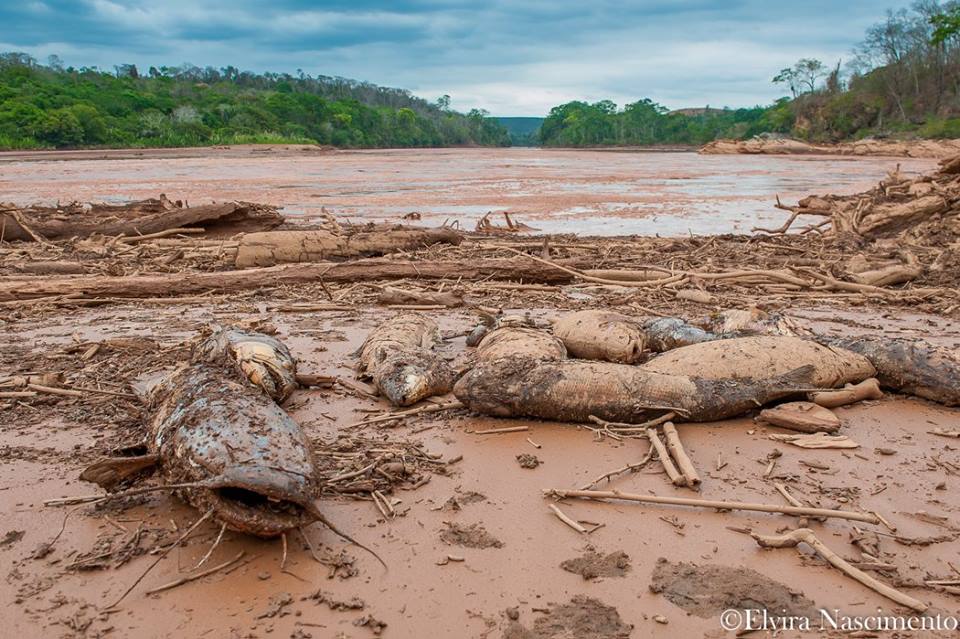
by Deep Green Resistance News Service | Nov 11, 2015 | Biodiversity & Habitat Destruction, Mining & Drilling, Toxification

Elvira Nascimento
Cyntia Beltrão reports from Brazil on what may be the country’s worst environmental disaster ever, at the Samarco open pit project jointly owned by Vale and BHP Billiton:
Last Thursday, November 5th, two dams containing mine tailings and waste from iron ore mining burst, burying the small historic town of Bento Rodrigues, district of Mariana, Minas Gerais state. The village, founded by miners, used to gain its sustenance from family farming and from labor at cooperatives. For many years, the people successfully resisted efforts to expel them by the all-powerful mining company Vale (NYSE: VALE, formerly Vale do Rio Doce, after the same river now affected by the disaster). Now their land is covered in mud, with the full scale of the death toll and environmental impacts still unknown.
Officially there are almost thirty dead, including small children, with several still missing. The press and the government hide the true numbers. Independent journalists say that the number of victims is much larger.
The environmental damage is devastating. The mud formed by iron ore and silica slurry spread over 410 miles. It reached one of the largest Brazilian rivers, the Rio Doce (“Sweet River”), at the center of our fifth largest watershed. The Doce River already suffers from pollution, silting of margins, cattle grazing in the basin land, and several eucalyptus plantations that drain the land. This year Southeastern Brazil, a region with a normally mild climate, endured a devastating drought. Authorities imposed water rationing on several major cities. Meanwhile, miners contaminate ground water and exploit lands rich in springs. The Doce River, once great and powerful, is now almost dry, even in its estuary. The mud of mining waste further injures the life of the river.
We do not know if the mud is contaminated by mercury and arsenic. Samarco / Vale says it isn’t, but we know that its components, iron ore and silica, will form a cement in the already dying river. This “cement” will change the riverbed permanently, covering the natural bed and artificially leveling its structure. The mud is sterile, and nothing will grow where it was deposited. A fish kill is already occuring. We do not know the full extent of impacts on river life or for those who depend on the river’s waters.
Soon the dirty mud will reach the sea, where it will cause further damage, to the important Rio Doce estuary and to the ocean.
 Some resources in Portuguese to learn more and get active:
Some resources in Portuguese to learn more and get active:
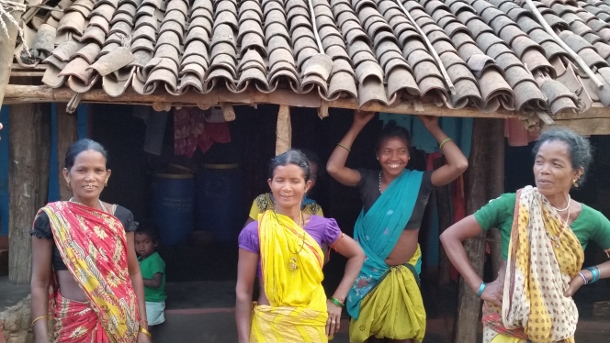
by DGR Colorado Plateau | Nov 7, 2015 | Colonialism & Conquest, Human Supremacy, Indigenous Autonomy, Indirect Action
In early October, news emerged that India’s Ministry of Environment, Forest and Climate Change was blocking the implementation of a high-level government panel’s report on tribal rights that recommended the creation of stringent rules to safeguard indigenous people from displacement. Meanwhile, two state governments have begun implementing a much different set of guidelines — issued in August without any interference — that allow the private sector to manage 40 percent of forests for profit at the expense of indigenous forest dwellers. In addition, another ordinance passed this year will permit private corporations to easily acquire land and forests from indigenous communities and carry out ecologically harmful mining. These legislative and policy decisions are usually made without the knowledge of indigenous communities whose lives, livelihoods and ecosystems will be worsened by these irresponsible actions of the government. Hence, indigenous communities in Uttar Pradesh, a northern state and Odisha, in the east, are strengthening their organizing to protect their rivers, lands, forests and hills from “development” that would displace thousands of local residents and destroy the environment.“People from my community and I were beaten, detained or jailed unnecessarily for opposing tree felling in our forests, some years ago,” said Nivada Debi, a feisty 38-year-old woman from the Tharu Adivasi community in Uttar Pradesh. “We visited the police station multiple times for their release. The government did not assist the injured. Despite the police and government indifference, we will fight for our land and environment.”A mother of four children subsisting on the forests, Debi is active in grassroots resistance that started nearly 20 years ago and has grown into the All India Union of Forest Working People, or AIUFWP. The group is made up of many indigenous people who subsist on forests and are collectively protecting forests from poachers and encroachers.
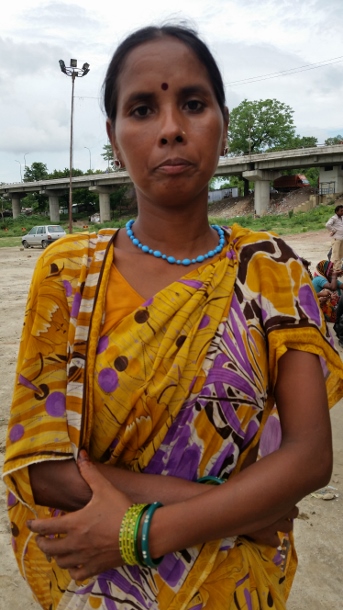
Debi was among hundreds — from the AIUFWP, the allied Save Kanhar Movement and other resistance groups — who traveled to Lucknow in July 2015 for a rally protesting the continued incarceration of their comrades fighting land grabbing in other districts of Uttar Pradesh. Roma Malik, the AIUFWP deputy general secretary, and Sukalo Gond, an Adivasi, which means original inhabitant, were among those arrested on June 30, before they were to address a large public gathering about the illegal land acquisition for the Kanhar dam and the violent repression of its opponents by the state. Another member of AIUFWP, Rajkumari, who prefers to go by her first name, was jailed on April 21, after 39 Adivasis and Dalits, who are considered outside the caste hierarchy, were brutally shot at by the police during a peaceful protest on April 18. The demonstration, which began on April 14 — the birthday of B.R. Ambedkar, the architect of the Indian constitution and an icon for many Indians, particularly Dalits — was opposing the construction of a dam across the Kanhar river in the Sonbhadra district of southeastern Uttar Pradesh.
Rajkumari was released toward the end of July while Gond and Malik were freed in September. However, others are still imprisoned on fabricated charges. Courts are delaying hearing their cases or denying them bail.
AIUFWP members, some of whom were previously involved with other local resistance movements, have been actively opposing the construction of the Kanhar dam for years. It would submerge over 10,000 acres of land from more than 110 villages in Uttar Pradesh and the neighboring states of Chattisgarh and Jharkhand, displacing thousands of local people and disrupting their lives and livelihoods. The dam was approved by the Central Water Commission of India in 1976, but was abandoned in 1989 after facing fierce opposition, especially from the local people whose lives and ecosystem would be destroyed by the proposed dam. However, construction resumed in December 2014, violating orders to stop it from the National Green Tribunal — a government body that adjudicates on environmental protection, forest conservation and natural resource disputes. No social impact assessment was done, nor were the necessary environmental or forest clearances — mandated by the Forest Conservation Act — obtained by the state government.
“Since this dam can destroy our survival and also adversely impact the surroundings, we have been opposing its construction and related land acquisition for many years,” said Shobha, a determined 42-year-old Dalit. “On December 23, 2014, the police caned some of our comrades when we were peacefully protesting the revival of building the dam earlier that month. However, the police falsely accused some leaders of our struggle of attacking the sub-divisional magistrate.” Shobha, who also prefers to go only by her first name, is among the vocal leaders of a women’s agricultural laborers union, which has allied with AIUFWP, in the village of Bada.
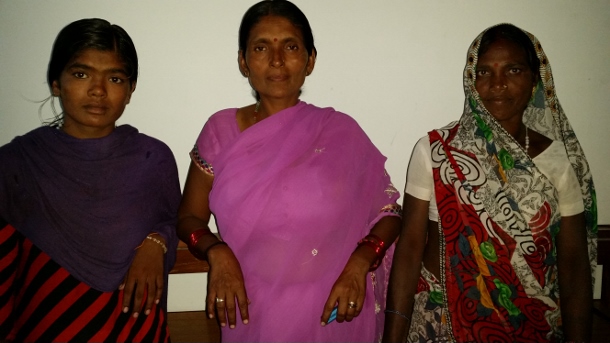
Around 400 miles from Sonbhadra, in the Kalahandi and Rayagada districts of southern Odisha, live the Dongria Kondhs, an indigenous community of over 8,000 people. They have been fighting tirelessly to protect their sacred mountain, the nearly 5,000-foot high Niyamgiri, from large private corporations — like Vedanta Limited — that are trying to mine bauxite in the area to produce aluminum. Supporters of the Dongria Kondhs were arrested in Delhi on August 9 outside the Reserve Bank of India, as they peacefully highlighted Vedanta’s illegitimate and harmful mining in the Niyamgiri. Vedanta’s mining would violate the Forest Rights Act, which states that indigenous communities are entitled to remain in the forests — and utilize the produce, land and water in the forests — while conserving and protecting them.
“The Niyamgiri symbolizes a parent to our community,” said Sadai Huika, a steadfast 45-year-old Dongria Kondh woman from Tikoripada village. “While the streams that originate from it help our farming, the plants and grass that grows on it feed our cattle and goats. We cannot exist without it and will safeguard it from anyone trying to harm it.”
Huika and people from hundreds of villages near the Niyamgiri are active members of the Niyamgiri Protection Forum, which originated around 2003 to resist attempts by Vedanta to begin mining where the Kondhs live, with the support of the Odisha state government. At every one of the 12 village council meetings with government officers held in 2013 atop the Niyamgari, community members stated that they would not allow mining nearby.
Kumuti Majhi, an elderly Dongria Kondh man and one of the forum’s leaders, is among the few people who have traveled within and outside Odisha to advocate against mining and garner vital support for their struggle. He has met ministers to explain how significant the Niyamgiri is to his community and their reasons for safeguarding it.
By organizing protests locally and with allies around the world — and meetings with Vedanta’s shareholders and empathetic government officials, who the forum has enlightened about the need to protect the Niyamgiri — the group has stalled the mining.
“We know that extracting bauxite from the Niyamgiri will pollute our environment and also affect all living beings here,” Majhi said. “Hence, we will stop anyone coming to plunder the Niyamgiri, despite police harassment and false charges against us and our families.”
Pushpa Achanta is a Bangalore-based freelance journalist, blogger and writer on development and human interest issues. She is the lead author of a book titled Ripples: The Right to Water and Sanitation for Whom, published in July 2013 by the Indian Social Institute in Bangalore. Her articles have appeared in collections of essays and features on different subjects. She also enjoys penning verse, taking nature photography and mentoring youth.
by DGR Colorado Plateau | Oct 30, 2015 | Indigenous Autonomy, Obstruction & Occupation
By SAVE Rivers, JOAS, The Borneo Project, BMF and BRIMAS / Intercontinental Cry
Indigenous resistance against the proposed Baram Dam receives international support for the celebration of the second year anniversary of the Baram Dam blockades: indigenous anti-dam activists from many parts of the world adopt declaration at the banks of the Baram River in Sarawak, Malaysia.
(BARAM / SARAWAK / MALAYSIA) On October 23rd 2015, indigenous communities from around the world gathered on the banks of the Baram River in Sarawak, Malaysia in the context of the second year anniversary of the indigenous-led blockades against the proposed Baram Dam. Two years ago indigenous communities set up two blockades and chased workers and researchers from the site. The works on the dam have come to a standstill and last month the government of Sarawak announced a moratorium.
Indigenous anti-dam activists from Indonesia, the Philippines, Cambodia, Brazil, the US, Honduras, and from around Malaysia united at the blockades to stand in solidarity with the resistance against the Baram Dam and to strengthen ties between their communities. The week-long event is called the World Indigenous Summit on Environment and Rivers, WISER Baram 2015, and was hosted by the grassroots network SAVE Rivers.

During celebrations at the two blockades, the proposed dam site, as well as at a conference in the town of Miri, the participants were united by the similarities between their struggles. “I have gained a lot of experience from all of the delegates. And with such information, I am confident enough such experiences will be fundamental to us – the Baram People – and our strategies to continue to fight and stop the proposed Baram Dam,” said James Nyurang, who hosted the delegates at his village.
According to Berta Cáceres, 2015 Goldman Prize winner from Honduras, “this summit on indigenous peoples and rivers has a special value in that its actions give strength to the historic resistance of our peoples and makes visible the grave aggressions and conflict generated by the privatization of rivers and the construction of dams within Indigenous communities and regions.”

The declaration also calls on governments and institutions to stop presenting dams as climate neutral, and recognize that dams emit large amounts of greenhouse gases, including methane.
Participants in the summit collectively produced a declaration that acknowledges the widespread suffering and destruction caused by dams, and stresses the importance of obtaining Free, Prior, and Informed Consent from communities impacted by dam building. It urges all stakeholders to act in full accountability, transparency, and compliance of all human rights principals and values.
The indigenous defense of the Baram river stands united with other communities’ struggles for land, livelihood, spirituality, identity, and community cohesion.






